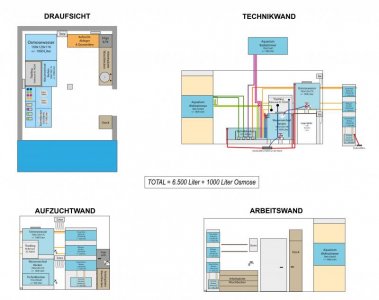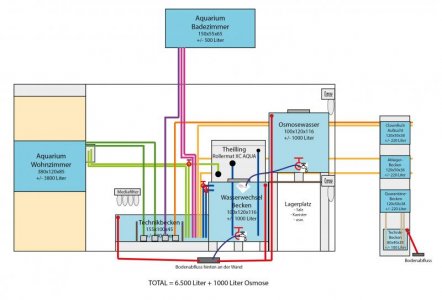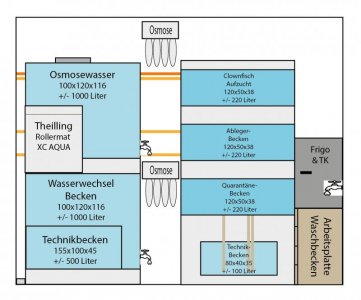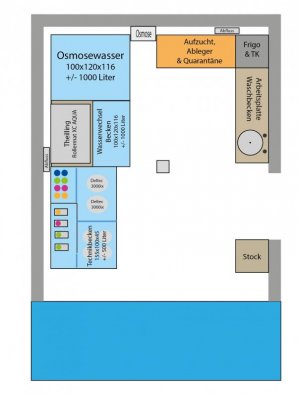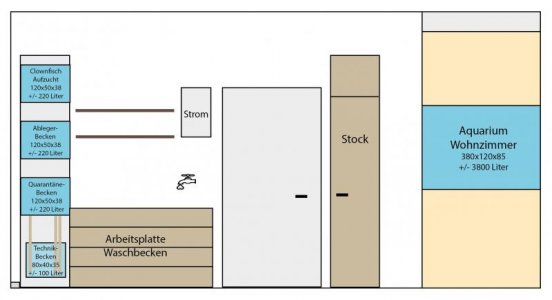Hello together 
At first sorry for my English, but I tried my best
I am currently planning my new house where several tanks will come. Attached you will find my sketches for this project and following a few explanations and introduction.
- Large tank: The tank measures 380 x 120 x 85 and is located in the middle of the house (see visualization). In this tank I would like to keep 1-2 blue spotted stingrays, but also emperor, doctor, butterfly,... Fishes. (Still have to check if they can all be socialized with the ray or can someone tell me something about that?). It should also be kept "easy" to keep corals, since some fish kept in the tank certainly go to corals. Behind the tank everything remains open towards the fish room. To the front, the substructure will be covered fixed and the upper structure with doors to be able to work on the tank from the front.
- Coral tank: This tank measures 150 x 55 x 65 is located on the upper floor in the bathroom. Since I don't want to put expensive corals in the large tank due to the fish I keep, I keep them in a separate tank focused on corals.
- High shelf tank: This tank contains 3 tanks of 120 x 50 x 38 each and is located in the equipment room. The 3 tanks are divided into a clownfish breeding tank, an frag tank and a quarantaine tank.
In total the circuit contains +/- 6500 liters and a 1000 liter ROI tank.
All 3 systems run off the same tech tank, except the quarantine tank runs separately. In addition, all of the tech tanks are provided with an emergency overflow that connects directly into the floor drain at the wall.
The drain of the technical tank in provided as follows:
The overflow from the large tank runs into theilling Rollermat and then into a 1000 liter IBC tank. From there it runs in the overflow into the sump. All other basin overflows as well as all emergency overflows of the 3 tanks run directly into the sump. The idea of the IBC tank is to be able to handle an easy water change. Next to the IBC tank there is another 1000 liter IBC tank filled with ROI water. This provides by a float for the automatic refilling of the evaporated water, besides, one can tap there ROI water. The ROI tank is also automatically refilled by a float with the increased ROI system.
The water change: During the water change, the supply of the large jaw to theilling is drained directly into the sump through a ball valve. In addition, the overflow from the IBC tank to the sump is turned off. So I can let the IBC tank run empty. Once that is empty, I fill it with the ROI water thanks to gravity and can add the salt. Once the parameters are right in the IBC tank, I integrate it back into the circuit and thus have a 1000 liter water change done without hopefully much effort. The idea comes from the following Youtube video (from minute 5:50) 360° SEA WATER AQUARIUM - 3500 liter system - TANK TOUR with corals and fish + tips - YouTube
The sump: no too big technique is currently foreseen. You will find two skimmers (for safety in case one fails), return pumps (for the big tank also for safety 2) and a media filter with dosing pump. Probably I will integrate a Mastertronic with the appropriate dosing pumps. The drainage is as follows. The water first goes to a small collection area, from there it runs over towards the skimmer. Then it goes on to an area where reactors, algae refugium or other things can be installed and further over an overflow to the return pumps.
Otherwise, in the fish room (342 x 417) there is a small refrigerator with freezer (for food, planktons, etc...), a work table with plastic basin and tall cabinet. Behind the big tank there is always at least 50 cm space to reach everywhere in the basin with a ladder. The lamps I guess to attach to a structure that can be raised by means of a rope tie to work better in the tank. The room will be tiled on the walls and in the middle of the room is a drain to which is the slope of the floor. In addition, there will be a seperate ventilation for the room, because I expect a high humidity.
This is the current state of planning. More detailed ideas on flow pumps, lamps, uvc, etc will come at the next step.
I would be happy to get feedback, opinions, ideas, suggestions for improvement.... from you
Enclosed a few small questions that are currently open with me:
- can I store the ROI water in the IBC tank for however long without it going bad or put a small flow pump in it?
- Does anyone know about keeping rays?
- What kind of ventilation would you recommend? I also have a small cavity in the bathroom above the tank that should be ventilated?
- How should a clownfish breeding be set up?
- Does a quarantine tank have to run continuously (even if no fish are currently in it) or can it be refilled with water from the loop when in use and then run on its own?
- How would you organize the circuits from the power? What technology should run off a safety switch? What should run on a backup battery and how should the backup battery be?
- What technology would you recommend?
- What material should the cladding of the tank be made of?
- Should the large tank be reinforced at the corners for safety and should an iron frame be installed at the bottom as well as the edge of the tank?
- Is the overflow on the large tank at the back of the tank feasible and durable in the long term or better to integrate in the tank?
That's it for now even if I certainly still have a thousand of questions
Thanks for your help
At first sorry for my English, but I tried my best
I am currently planning my new house where several tanks will come. Attached you will find my sketches for this project and following a few explanations and introduction.
- Large tank: The tank measures 380 x 120 x 85 and is located in the middle of the house (see visualization). In this tank I would like to keep 1-2 blue spotted stingrays, but also emperor, doctor, butterfly,... Fishes. (Still have to check if they can all be socialized with the ray or can someone tell me something about that?). It should also be kept "easy" to keep corals, since some fish kept in the tank certainly go to corals. Behind the tank everything remains open towards the fish room. To the front, the substructure will be covered fixed and the upper structure with doors to be able to work on the tank from the front.
- Coral tank: This tank measures 150 x 55 x 65 is located on the upper floor in the bathroom. Since I don't want to put expensive corals in the large tank due to the fish I keep, I keep them in a separate tank focused on corals.
- High shelf tank: This tank contains 3 tanks of 120 x 50 x 38 each and is located in the equipment room. The 3 tanks are divided into a clownfish breeding tank, an frag tank and a quarantaine tank.
In total the circuit contains +/- 6500 liters and a 1000 liter ROI tank.
All 3 systems run off the same tech tank, except the quarantine tank runs separately. In addition, all of the tech tanks are provided with an emergency overflow that connects directly into the floor drain at the wall.
The drain of the technical tank in provided as follows:
The overflow from the large tank runs into theilling Rollermat and then into a 1000 liter IBC tank. From there it runs in the overflow into the sump. All other basin overflows as well as all emergency overflows of the 3 tanks run directly into the sump. The idea of the IBC tank is to be able to handle an easy water change. Next to the IBC tank there is another 1000 liter IBC tank filled with ROI water. This provides by a float for the automatic refilling of the evaporated water, besides, one can tap there ROI water. The ROI tank is also automatically refilled by a float with the increased ROI system.
The water change: During the water change, the supply of the large jaw to theilling is drained directly into the sump through a ball valve. In addition, the overflow from the IBC tank to the sump is turned off. So I can let the IBC tank run empty. Once that is empty, I fill it with the ROI water thanks to gravity and can add the salt. Once the parameters are right in the IBC tank, I integrate it back into the circuit and thus have a 1000 liter water change done without hopefully much effort. The idea comes from the following Youtube video (from minute 5:50) 360° SEA WATER AQUARIUM - 3500 liter system - TANK TOUR with corals and fish + tips - YouTube
The sump: no too big technique is currently foreseen. You will find two skimmers (for safety in case one fails), return pumps (for the big tank also for safety 2) and a media filter with dosing pump. Probably I will integrate a Mastertronic with the appropriate dosing pumps. The drainage is as follows. The water first goes to a small collection area, from there it runs over towards the skimmer. Then it goes on to an area where reactors, algae refugium or other things can be installed and further over an overflow to the return pumps.
Otherwise, in the fish room (342 x 417) there is a small refrigerator with freezer (for food, planktons, etc...), a work table with plastic basin and tall cabinet. Behind the big tank there is always at least 50 cm space to reach everywhere in the basin with a ladder. The lamps I guess to attach to a structure that can be raised by means of a rope tie to work better in the tank. The room will be tiled on the walls and in the middle of the room is a drain to which is the slope of the floor. In addition, there will be a seperate ventilation for the room, because I expect a high humidity.
This is the current state of planning. More detailed ideas on flow pumps, lamps, uvc, etc will come at the next step.
I would be happy to get feedback, opinions, ideas, suggestions for improvement.... from you
Enclosed a few small questions that are currently open with me:
- can I store the ROI water in the IBC tank for however long without it going bad or put a small flow pump in it?
- Does anyone know about keeping rays?
- What kind of ventilation would you recommend? I also have a small cavity in the bathroom above the tank that should be ventilated?
- How should a clownfish breeding be set up?
- Does a quarantine tank have to run continuously (even if no fish are currently in it) or can it be refilled with water from the loop when in use and then run on its own?
- How would you organize the circuits from the power? What technology should run off a safety switch? What should run on a backup battery and how should the backup battery be?
- What technology would you recommend?
- What material should the cladding of the tank be made of?
- Should the large tank be reinforced at the corners for safety and should an iron frame be installed at the bottom as well as the edge of the tank?
- Is the overflow on the large tank at the back of the tank feasible and durable in the long term or better to integrate in the tank?
That's it for now even if I certainly still have a thousand of questions
Thanks for your help

